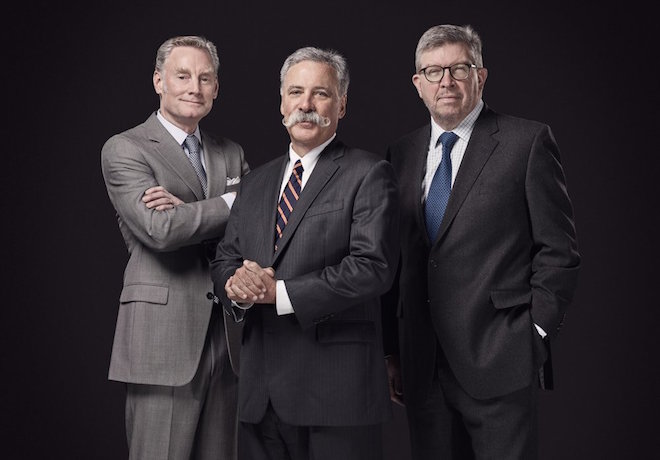Liberty proposes $150m budget cap
 |
| Bratches, Carey and Brawn lay out F1's way forward |
Following days, weeks, months of speculation, this morning F1's owners, Liberty Media, laid out its blueprint for the future of the sport.
Rather than being a meeting, representatives of all ten teams were present as Liberty offered its proposals, the presentation lasting around 75 minutes. At the end of the presentation, the team representatives were each handed a sheet of document which contained further details of the proposals.
It's understood that Liberty is intending a $150m budget cap but this would not include driver salaries or key executives or marketing budget.
The budget cap would be introduced in two stages for the benefit of the bigger teams which would clearly have to lay-off staff.
Liberty claims the redistribution of the prize pot will leave the teams that much better off that even the smallest will only need to raise around $30m in sponsorship in order to reach the $150m limit.
Ferrari would continue to receive a special historic bonus but this would be reduced from $100m to $50m, while all the engine manufacturers would receive a bonus understood to be in the region of $10m.
While the teams, most notably Ferrari and Mercedes, have yet to react, it is understood that the proposals, which have the full support of the FIA, are not up for discussion but rather 'take it or leave (it)'.
Interestingly, in the moments following the presentation, Toto Wolff and Niki Lauda were seen in earnest discussion with Maurizio Arrivabene in the Mercedes hospitality unit. Oh to be a fly…
 |
| Team bosses leave the Liberty meeting |
In terms of the engine formula, with the manufacturers offering no alternatives it would appear that Liberty will stick to its initial proposal which saw the standardisation of more parts, an increased rev limit, a relaxation of the fuel limit rules, a stronger MGU-K and the dropping of the MGU-H.
"Formula 1 is a sport with a rich history," said F1 boss Chase Carey in a subsequent statement. "We want to preserve, protect and enhance that history by unleashing F1's potential, by putting our fans at the heart of a more competitive and more exciting sport.
"We are driven by one desire: to create the world's leading sporting brand. Fan- centred, commercially successful, profitable for our teams, and with technological innovation at its heart."
The proposals break down as follows:
Power units
The PU must be cheaper, simpler, louder, have more power and reduce the necessity of grid penalties.
It must remain road relevant, hybrid and allow manufacturers to build unique and original PU.
New PU rules must be attractive for new entrants and Customer teams must have access to equivalent performance.
Costs
We believe how you spend the money must be more decisive and important than how much money you spend.
While there will be some standardised elements, car differentiation must remain a core value
Implement a cost cap that maintains Formula 1 position as the pinnacle of motorsport with a state-of-the-art technology.
Revenues
 |
| Horner, Arrivabene and Wolff exchange thoughts on Liberty's proposals |
The new revenue distribution criteria must be more balanced, based on meritocracy of the current performance and reward success for the teams and the Commercial Rights Holder.
F1s unique, historical franchise and value must and will still be recognised.
Revenue support to both cars and engine suppliers.
Sporting and technical rules & regulations
We must make cars more raceable to increase overtaking opportunities.
Engineering technology must remain a cornerstone but driver's skill must be the predominant factor in the performance of the car.
The cars must and will remain different from each other and maintain performance differentiators like aerodynamics, suspensions and PU performance. However, we believe areas not relevant to fans need to be standardised.
Governance
A simple and streamline structure between the teams, the FIA and Formula 1.
